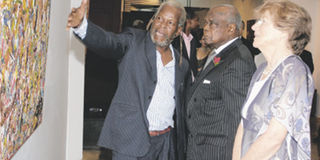Relief in local art circles as Gallery Watatu is revived

Wanyu Brush (left), an artist at Gallery Watatu, shows off an art piece to guest of honour former Attorney General Charles Njonjo and his wife, Margaret, during the re-launch of the gallery at Lonrho House in Nairobi on Friday last week. Gallery Watatu had been closed for 15 years. CHARLES KAMAU
Fifteen years ago, the oils and brushes at one of Kenya’s most promising art galleries were packed and kept away.
A great supporter of contemporary art in East Africa, Ruth Schaffner, a German-born American collector of post-war art, had breathed her last.
Ms Schaffner, and her husband, Adama Diawara, the then Cote d’Ivoire consul-general to Kenya, had together kept the walls of Gallery Watatu alive since 1968.
Ms Schaffner’s demise sounded the death knell for nearly 150 artists based at the gallery.
But a few of the artists soldiered on, taking their art out to studios in Banana Hill, along Forest Road, Ngong Road, Ngecha and Naivasha.
Last Friday at Lonrho House on Nairobi’s Standard Street, Gallery Watatu was reborn. The rebirth was marked by an exhibition of three East African veterans of contemporary art — Jak Katarikawe, Wanyu Brush and Sane Wadu.
The guest of honour was former attorney General Charles Njonjo. He told how he had been a regular visitor to the gallery and how painters such as Jony Waite and Robin Anderson were moulded there.
“I had more energy. Watatu will always be remembered as having contributed to the development of contemporary art in the region,” Mr Njonjo said.
Colourful artworks of the three painters took up all four corners of the gallery.
Keenly studying a painting titled Ocampo Hundred by Wanyu Brush, one of the guests, Wambui Mwangi, remarked: “This is impressive.”
Brush’s work is colourful and incorporates abstract swirls.
Known at birth as John Njenga Kamau, his other works at the exhibition are Our Stolen Innocence, Exodus, Day of Great Shame in the Land, We Shall Be Happy and Free No Matter What and Never, Never, Never Again.
“The post-election violence inspired my painting. People were killing each other because of politics,” he says.
When Gallery Watatu stopped exhibiting, Brush says, he kept a low profile in Ngecha waiting for people to buy his paintings.
Besides Sane Wadu’s painting, Peace and Harmony Shall Bless the Land, Katherine Kariuki says she is trying to see where the peace and harmony is.
Nyambura Wanyoike marvelled at Katarikawe’s painting, Don’t Hide My Child Bring Him, saying though Wadu’s paintings are really colourful, Katarikawe’s are easy on the eye.
The consensus among the guests was that Katarikawe was the only one exploring social themes in Wedding Night, Beauty Contest and She is so Beautiful, All Men want Her.
“We are getting old, I draw dreams. When I finish I want someone to tell the story,” says Katarikawe, who started painting in 1962 in Kigezi, Uganda.
Osei Kofi, the chief executive-designate of Gallery Watatu, says: “The gallery never closed. It has been there for 44 years. It is re-dedication and we are trying to fine tune and do something extra. We are installing infrastructure for the artists and facilitating a new way of art.
“We want Kenyans to constitute 50 per cent of Watatu market in five years. We want more Kenyans and others in the region to discover a broader dimension in acquiring art; to enjoy what one buys, certainly, but to also see its potential as an economic asset,” Kofi said. The gallery can only accommodate 36 artists, he said.



